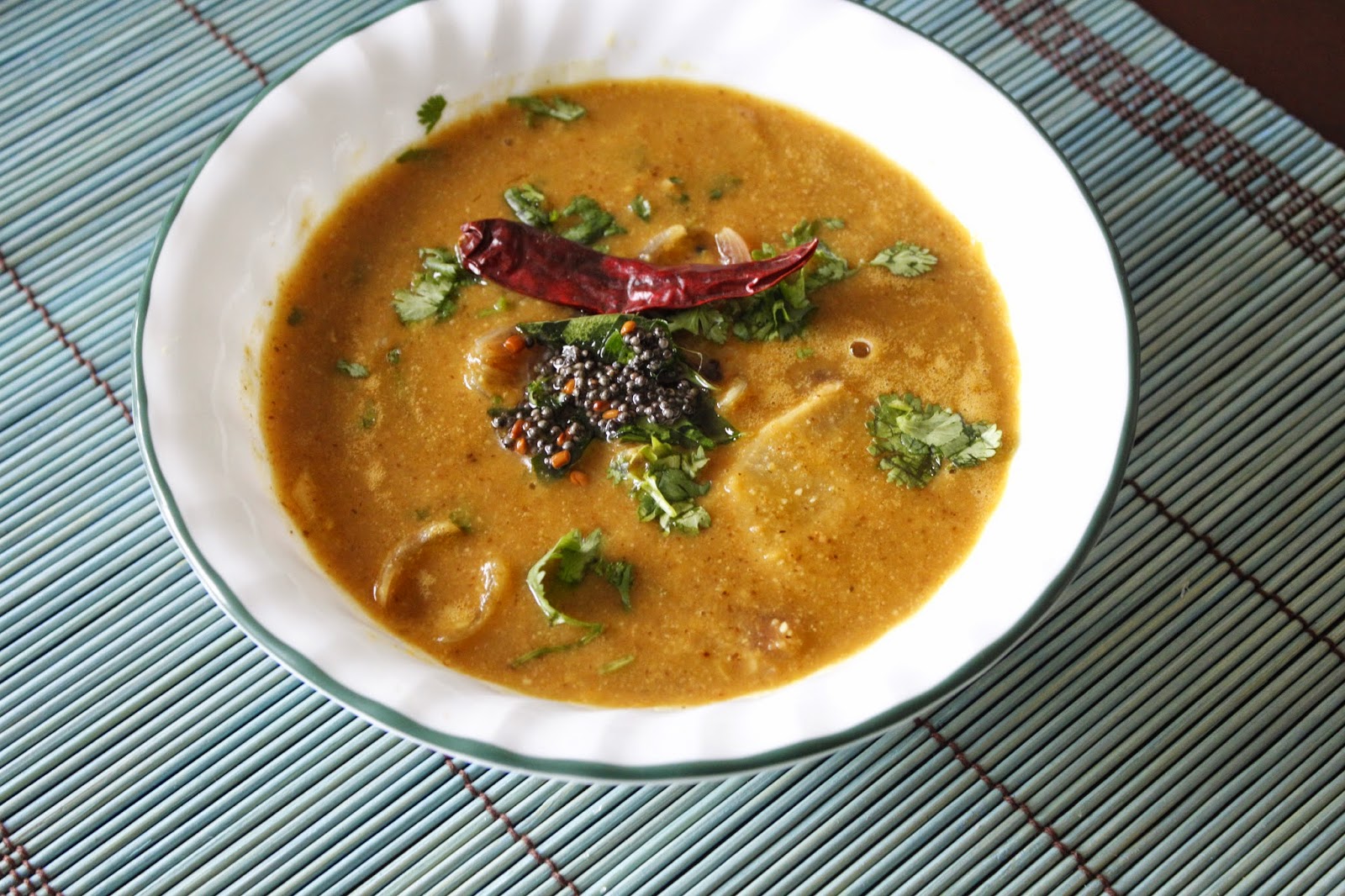Arachu vitta sambar, meaning, sambar made with freshly ground spices, is a slightly special and tastier version of regular sambar (which is a tamarind and lentil stew made with vegetable/s or greens). It is commonly made during festive and special occasions, but in our house, I usually make only this kind of sambar, because it so much more flavorful with just a little extra step. Plus, adding freshly ground spices makes the sambar attain its optimum consistency every single time! It's rich, thick, and a very easy crowd pleaser!
In this recipe, I have added pearl onions and radish/daikon to make this sambar. Pearl onions (chinna vengayam) are a popular choice for this kind of sambar. You can add any (diced) vegetable/s of your choice using this basic procedure. Here's how it's done.
For more information on the Indian ingredients listed here, please refer to the Glossary.
Ingredients (4-6):
- 3/4 cup toor dal / tuvaram paruppu / yellow lentils, uncooked
- 3/4 cup pearl onions, peeled and sliced
- 1/2 cup radish / daikon, peeled and sliced
- 1.5 inch ball of tamarind soaked in 1 cup of hot water for 20-30 minutes
- 1 heaped teaspoon sambar powder
- 1.5 tablespoons bengal gram / kadala paruppu / channa dal
- 3 tablespoons coriander seeds / dhania
- 2-3 dry red chillies
- 1/3 cup grated coconut
- 1 teaspoon raw white rice (optional)
- 1 teaspoon grated jaggery
- 1 teaspoon black mustard seeds
- 1/4 teaspoon fenugreek seeds / methi / vendhayam
- 1/4 cup chopped coriander leaves
- a few curry leaves
- 1/4 teaspoon hing / asafoetida
- salt, as needed
- 2 + 1 tablespoons vegetable oil
- 1 tablespoon clarified butter (ghee) / coconut oil
- Cook the lentils with 2 cups of water until mushy. A pressure cooker works best.
- Extract tamarind juice from the soaked tamarind. Add another 1 cup of warm water to the tamarind pulp and extract more juice. This will result in a total of 2 1/4 cups of tamarind juice.
- Heat 2 tablespoons vegetable oil in a medium to large sauce-pan. When hot, add the pearl onions and fry on medium heat until translucent. Add the sliced radish and fry for 2 minutes.
- Add sambar powder and stir fry with the vegetables for a minute. Add the extracted tamarind juice and 1 more cup of water and boil with salt for 20 minutes or so on medium heat until the tamarind doesn't smell raw.
- Meanwhile, heat a tablespoon of vegetable oil in a pan. First fry red chillies, hing, and bengal gram until the gram changes color. Remove from the pan. Then, add the coriander seeds and fry until they change color. Remove from the pan. Roast white rice until it begins to toast lightly, and remove from the pan. Switch off the heat. In the remaining heat of the pan, lightly toast the coconut. Grind all this with a little water to make a thick paste.
- Add this paste to the tamarind stew along with jaggery and mix well.
- Add the cooked dal, mix and cook on low heat for 7-10 minutes.
- Heat ghee or coconut oil. When hot, splutter mustard seeds. Add fenugreek seeds and curry leaves and fry of a couple of seconds. Add this to the hot sambar and mix. Garnish with chopped cilantro and cover the sambar until ready to serve
Note: Somehow, consistency is hardly an issue with Arachu vitta sambar. I think the freshly ground spices adequately thicken the sambar to the right proportion. If you think the sambar is too thick (like a kootu), add some warm water and bring to a boil and switch off. If you think the sambar is thin in consistency (unlikely), then dissolve 1/2 a tablespoon of rice flour in water to make a paste. Add this to the sambar and whisk well to incorporate. Cook on low heat for 5-7 minutes until the sambar thickens.
Variations:
Pitlai and Rasavaangi are close relatives of arachu vitta sambar. The only main differences are that they are made with more lentils, so they are thicker in consistency (a hybrid of kootu and sambar). Also, pilai is commonly made with bitter-gourd, while rasavaangi is made with eggplants/brinjals or certain kinds of pumpkins.
Thiruvathirai sambar (that's made to accompany Kali) is prepared in the exact same way as arachu vitta sambar, except we add at least 5 or 7 (or 9) different types of vegetables to the sambar. Sweet potato and carrots are commonly added to this sambar to bring a subtle sweetness. Again, I very frequently make this kind of sambar because it is packed with vegetables and lentils, and is so flavorful!



No comments:
Post a Comment
Thanks for leaving a comment! I appreciate it.
Note: Only a member of this blog may post a comment.